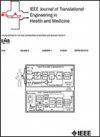将非平方滤波和边界增强集成到编码器-解码器网络中用于大尺寸低分辨率骨闪烁图的病灶感知分割
IF 4.4
3区 医学
Q2 ENGINEERING, BIOMEDICAL
IEEE Journal of Translational Engineering in Health and Medicine-Jtehm
Pub Date : 2025-09-02
DOI:10.1109/JTEHM.2025.3605042
引用次数: 0
摘要
背景:准确识别肺癌骨转移对有效诊断和治疗至关重要。然而,现有的检测骨转移的方法面临着显著的局限性,特别是在全身骨扫描中,由于低分辨率、模糊的边界以及病变形状和大小的可变性,这对传统的卷积神经网络构成了挑战。目的:为了准确地从全身骨扫描中分离转移病灶,我们提出了一种使用深度学习技术的病灶感知分割模型。方法:该模型将病灶边界引导策略、多尺度学习和图像形状引导集成到一个编码器-解码器架构网络中。该方法显著提高了低分辨率和模糊边界条件下的分割性能,同时有效地管理了病灶形状的可变性,减轻了图像矩形格式的干扰。结果:对274个全身骨扫描的临床数据进行的实验评估表明,与专门用于全身骨扫描的分割模型相比,所提出的模型在骰子相似系数上提高了7.45%,在召回率上提高了11.75%,在关键指标上取得了显着的改进和平衡的性能。结论:该模型为肺癌骨转移的识别提供了更准确、更高效的解决方案,缓解了基于深度学习的低分辨率、大尺寸全身骨扫描医学图像自动分析的挑战。该代码可在https://github.com/carorange/segmentation临床和影响:这种病变感知深度学习模型提供了一个强大的自动化解决方案,用于在低分辨率、大规模全身骨骼扫描中识别骨转移,从而实现更早、更准确的临床决策,并有可能改善肺癌治疗的患者结果。本文章由计算机程序翻译,如有差异,请以英文原文为准。
Integrating Non-Square Filter and Boundary Enhancement Into Encoder–Decoder Network for Lesion-Aware Segmentation of Large-Size Low-Resolution Bone Scintigrams
Background: Accurate identification of bone metastases in lung cancer is essential for effective diagnosis and treatment. However, existing methods for detecting bone metastases face significant limitations, particularly in whole-body bone scans, due to low resolution, blurred boundaries, and the variability in lesion shapes and sizes, which challenge traditional convolutional neural networks. Purpose: To accurately isolate the metastasized lesions from whole-body bone scans, we propose a lesion-aware segmentation model using deep learning techniques. Methods: The proposed model integrates lesion boundary-guided strategies, multi-scale learning, and image shape guidance into an encoder-decoder architecture network. This approach significantly improves segmentation performance in low-resolution and blurred boundary conditions while effectively managing lesion shape variability and mitigating interference from the rectangular format of the images. Results: Experimental evaluations conducted on clinical data of 274 whole-body bone scans demonstrate that the proposed model achieves a 7.45% improvement in the Dice Similarity Coefficient and a 11.75% improvement in Recall compared to specialized segmentation models for whole-body bone scans, achieving significant improvements and balanced performance across key metrics. Conclusions: This model offers a more accurate and efficient solution for identifying bone metastases in lung cancer, alleviating the challenges of deep learning-based automated analysis of low-resolution, large-size medical images of whole-body bone scans. The code is available at https://github.com/carorange/segmentation Clinical and Impact: This lesion-aware deep learning model provides a robust, automated solution for identifying bone metastases in low-resolution, large-scale whole-body bone scans, enabling earlier and more accurate clinical decisions and potentially improving patient outcomes in lung cancer care.
求助全文
通过发布文献求助,成功后即可免费获取论文全文。
去求助
来源期刊

IEEE Journal of Translational Engineering in Health and Medicine-Jtehm
Engineering-Biomedical Engineering
CiteScore
7.40
自引率
2.90%
发文量
65
审稿时长
27 weeks
期刊介绍:
The IEEE Journal of Translational Engineering in Health and Medicine is an open access product that bridges the engineering and clinical worlds, focusing on detailed descriptions of advanced technical solutions to a clinical need along with clinical results and healthcare relevance. The journal provides a platform for state-of-the-art technology directions in the interdisciplinary field of biomedical engineering, embracing engineering, life sciences and medicine. A unique aspect of the journal is its ability to foster a collaboration between physicians and engineers for presenting broad and compelling real world technological and engineering solutions that can be implemented in the interest of improving quality of patient care and treatment outcomes, thereby reducing costs and improving efficiency. The journal provides an active forum for clinical research and relevant state-of the-art technology for members of all the IEEE societies that have an interest in biomedical engineering as well as reaching out directly to physicians and the medical community through the American Medical Association (AMA) and other clinical societies. The scope of the journal includes, but is not limited, to topics on: Medical devices, healthcare delivery systems, global healthcare initiatives, and ICT based services; Technological relevance to healthcare cost reduction; Technology affecting healthcare management, decision-making, and policy; Advanced technical work that is applied to solving specific clinical needs.
 求助内容:
求助内容: 应助结果提醒方式:
应助结果提醒方式:


